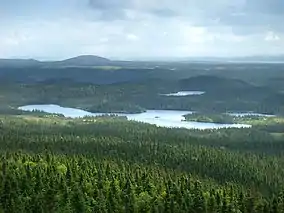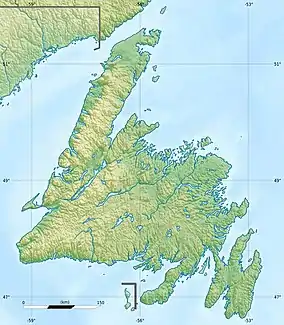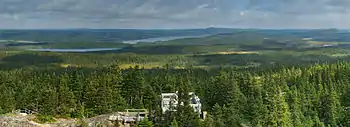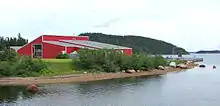Terra Nova National Park
Terra Nova National Park is located on the east coast of Newfoundland in the Canadian province of Newfoundland and Labrador, along several inlets of Bonavista Bay. The park takes its name from the Latin name for Newfoundland; it is also the original Portuguese name given to the region.[1]
| Terra Nova National Park | |
|---|---|
IUCN category II (national park) | |
 View from Ochre Hill | |
 Location of Terra Nova National Park in Canada  Location of Terra Nova National Park in Newfoundland | |
| Location | Sandringham, Newfoundland and Labrador |
| Coordinates | 48°31′50″N 53°55′41″W |
| Area | 399 km2 (154 sq mi) |
| Established | 1957 |
| Governing body | Parks Canada |
Terra Nova's landscape is typical of the northeast coast of Newfoundland, but with remnants of the Appalachian Mountains contributing to widely varied and rugged topography throughout the region. The park's seacoast consists of several rocky "fingers" jutting into Bonavista Bay along an area stretching from just north of Port Blandford to the vicinity of Glovertown. The coastline varies from cliffs and exposed headlands to sheltered inlets and coves, contributing to Newfoundland's prime recreational boating area.
Inland areas consist of rolling forested hills, exposed rock faces, and bogs, ponds and wetlands. Wildlife protected by the park range from small to large land mammals, migratory birds, and various marine life. Terra Nova also protects an area containing remnants of the Beothuk Nation, as well as many of the early pioneer European settlements in the region.
Terra Nova National Park was established in 1957 and was the first National Park in Newfoundland and Labrador. Terra Nova protects the Eastern Island Boreal Forest natural region. This region covers most of the island of Newfoundland, east of Deer Lake, and is characterized by black spruce trees with pockets of balsam fir, white pine, mountain ash, tamarack, maple and other deciduous tree species.
Challenges

Terra Nova, like many parks, has challenges in preserving its ecological integrity. Firstly, one of the mechanisms to renew a boreal forest ecosystem is forest fire - something that hasn't happened in the region in over 35 years. As a result, the forest of Terra Nova is mixed. It is mostly old growth forest with trees of roughly the 10–20 years of age. Forest fire renews the forest and creates new habitat for many boreal creatures. Another challenge facing Terra Nova is introduced species. Newfoundland suffers from "the island effect". Islands can have very different ecosystems than their mainland counterparts. For example, the island of Newfoundland only has 7 native mammals while neighboring Nova Scotia has over 63.
Activities


There are two campgrounds that offer front country camping: Newman Sound and Malady Head. There are also a number of backcountry camping areas that you can hike, canoe or kayak to. There are many trails in the park of varying length and difficulty. The main visitor centre is located at Salton's Brook.
During the summer there are a number of interpretive programs offered at Terra Nova. Almost every night there is a show at the Evening Theatre about the themes of the Park. Current shows include "Go With the Flo" and "Forest Idol." Previous shows include "Forest Feud" and "The Broad Cove Bachelor". Once a week there is also a campfire program at the campfire circle where you can listen to some sounds of Newfoundland while sipping hot chocolate. There are also a number of interpretive hikes that cover themes such as introduced species, forest fire, species at risk, and edible plants.
Other summer activities at the park include freshwater swimming and mountain biking.[2]
There are a number of activities for kids. One of the more popular programs is the Junior Naturalist Program where children get stamps towards becoming a junior naturalist. There is also a Graduate Naturalist Program where older children get a workbook with many fun activities to complete.
Terra Nova also organizes and celebrates a number of special events. Some of the more popular include Canada Day (July 1), Kids day, Newfoundland and Labrador day, Take a Hike Day, Oceans Day (June 8).
Winter activities at the park include winter camping, snowshoeing and cross-country skiing.[2]
Fauna
Animals that inhabit this national park are coyotes, black bears, moose, caribou, black ducks, red foxes, beavers, bald eagles, red squirrels, river otters, lynxes, puffins, snowshoe hares, ospreys, pine martens, and minks. Marine animals that inhabit offshore are humpback whales, minke whales, fin whales, pilot whales, harp seals, orcas and dolphins.
Geology
The park resides in what is termed the Avalon Zone, named for the Avalon Peninsula, and associated with the Appalachian Orogen. The zone's western boundary is marked by the Dover Fault and the Hermitage Bay Fault. The eastern portion of the park is characterized by the Precambrian Connecting Point Group quartzite, slate, and greywacke. The Precambrian Musgraventown Group reddish sandstone, conglomerate, and argillite are exposed along the Trans Canada Highway, and westernmost portion of the park, sandwiching the Precambrian Love Cove Group sericite and chlorite schists. A Pleistocene ice cap flowed radially across the island, depositing glacial debris in the western part of the park.[3][4]
Climate
| Climate data for Terra Nova National Park Headquarters (1981−2010) | |||||||||||||
|---|---|---|---|---|---|---|---|---|---|---|---|---|---|
| Month | Jan | Feb | Mar | Apr | May | Jun | Jul | Aug | Sep | Oct | Nov | Dec | Year |
| Record high °C (°F) | 12.5 (54.5) |
14.5 (58.1) |
16.5 (61.7) |
23.0 (73.4) |
28.5 (83.3) |
32.2 (90.0) |
33.0 (91.4) |
34.0 (93.2) |
28.5 (83.3) |
24.0 (75.2) |
19.4 (66.9) |
16.1 (61.0) |
34.0 (93.2) |
| Average high °C (°F) | −2.5 (27.5) |
−2.2 (28.0) |
1.1 (34.0) |
2.5 (36.5) |
12.3 (54.1) |
17.0 (62.6) |
21.7 (71.1) |
21.6 (70.9) |
16.7 (62.1) |
10.5 (50.9) |
5.0 (41.0) |
−0.1 (31.8) |
9.0 (48.2) |
| Daily mean °C (°F) | −6.9 (19.6) |
−6.8 (19.8) |
−3.2 (26.2) |
1.01 (33.82) |
7.3 (45.1) |
11.6 (52.9) |
16.2 (61.2) |
16.4 (61.5) |
12.0 (53.6) |
6.7 (44.1) |
1.6 (34.9) |
−3.7 (25.3) |
4.4 (39.9) |
| Average low °C (°F) | −11.3 (11.7) |
−11.5 (11.3) |
−7.5 (18.5) |
−12.4 (9.7) |
2.2 (36.0) |
6.1 (43.0) |
10.6 (51.1) |
11.2 (52.2) |
7.2 (45.0) |
2.8 (37.0) |
−1.8 (28.8) |
−7.4 (18.7) |
−0.1 (31.8) |
| Record low °C (°F) | −27.8 (−18.0) |
−27.5 (−17.5) |
−28.5 (−19.3) |
−18.0 (−0.4) |
−9.4 (15.1) |
−3.9 (25.0) |
1.0 (33.8) |
−2.0 (28.4) |
−5.0 (23.0) |
−8.0 (17.6) |
−16.5 (2.3) |
−22.8 (−9.0) |
−28.5 (−19.3) |
| Average precipitation mm (inches) | 110.8 (4.36) |
118.4 (4.66) |
103.2 (4.06) |
91.3 (3.59) |
82.3 (3.24) |
102.7 (4.04) |
98.5 (3.88) |
88.0 (3.46) |
119.4 (4.70) |
105.5 (4.15) |
97.4 (3.83) |
116.0 (4.57) |
1,233.5 (48.56) |
| Average rainfall mm (inches) | 33.4 (1.31) |
37.9 (1.49) |
47.1 (1.85) |
64.5 (2.54) |
79.7 (3.14) |
102.6 (4.04) |
98.5 (3.88) |
88.0 (3.46) |
119.4 (4.70) |
103.3 (4.07) |
72.0 (2.83) |
46.1 (1.81) |
892.3 (35.13) |
| Average snowfall cm (inches) | 78.7 (31.0) |
82.3 (32.4) |
56.8 (22.4) |
45.8 (18.0) |
2.6 (1.0) |
0.13 (0.05) |
0.0 (0.0) |
0.0 (0.0) |
0.0 (0.0) |
2.2 (0.9) |
25.2 (9.9) |
67.2 (26.5) |
340.9 (134.2) |
| Average precipitation days (≥ 0.2 mm) | 14.2 | 14.2 | 14.5 | 15.3 | 17.7 | 17.6 | 15.4 | 14.8 | 17.3 | 17.8 | 16.6 | 17.1 | 192.4 |
| Average rainy days (≥ 0.2 mm) | 4.0 | 4.9 | 7.9 | 12.4 | 17.1 | 17.6 | 15.4 | 14.8 | 17.3 | 17.6 | 13.5 | 7.7 | 150.2 |
| Average snowy days (≥ 0.2 cm) | 11.0 | 10.9 | 8.4 | 4.9 | 0.87 | 0.06 | 0.0 | 0.0 | 0.0 | 0.56 | 4.3 | 10.9 | 52.0 |
| Source: Environment Canada[5] | |||||||||||||
References
- Hamilton, William B. (1978): The Macmillan book of Canadian place names, Macmillan of Canada, Toronto, p. 105.
- National Geographic Guide to the National Parks of Canada, 2nd Edition. National Geographic Society. 2016. pp. 16–21. ISBN 978-1-4262-1756-2.
- Williams, Harold (1995). Geology of the Appalachian-Caledonian Orogen in Canada and Greenland, Geology of Canada, no. 6. Canada: Geological Survey of Canada. pp. 223–227, 230, 232. ISBN 0-660-13134-X.
- Baird, D.M. (1966). Rocks and Scenery of Terra Nova National Park. Ottawa: Geological Survey of Canada. p. 3,9–14,26–28.
- "Terra Nova Nat Park HQ". Canadian Climate Normals 1981–2010. Environment Canada. Retrieved November 26, 2013.
External links
| Wikimedia Commons has media related to Terra Nova National Park. |